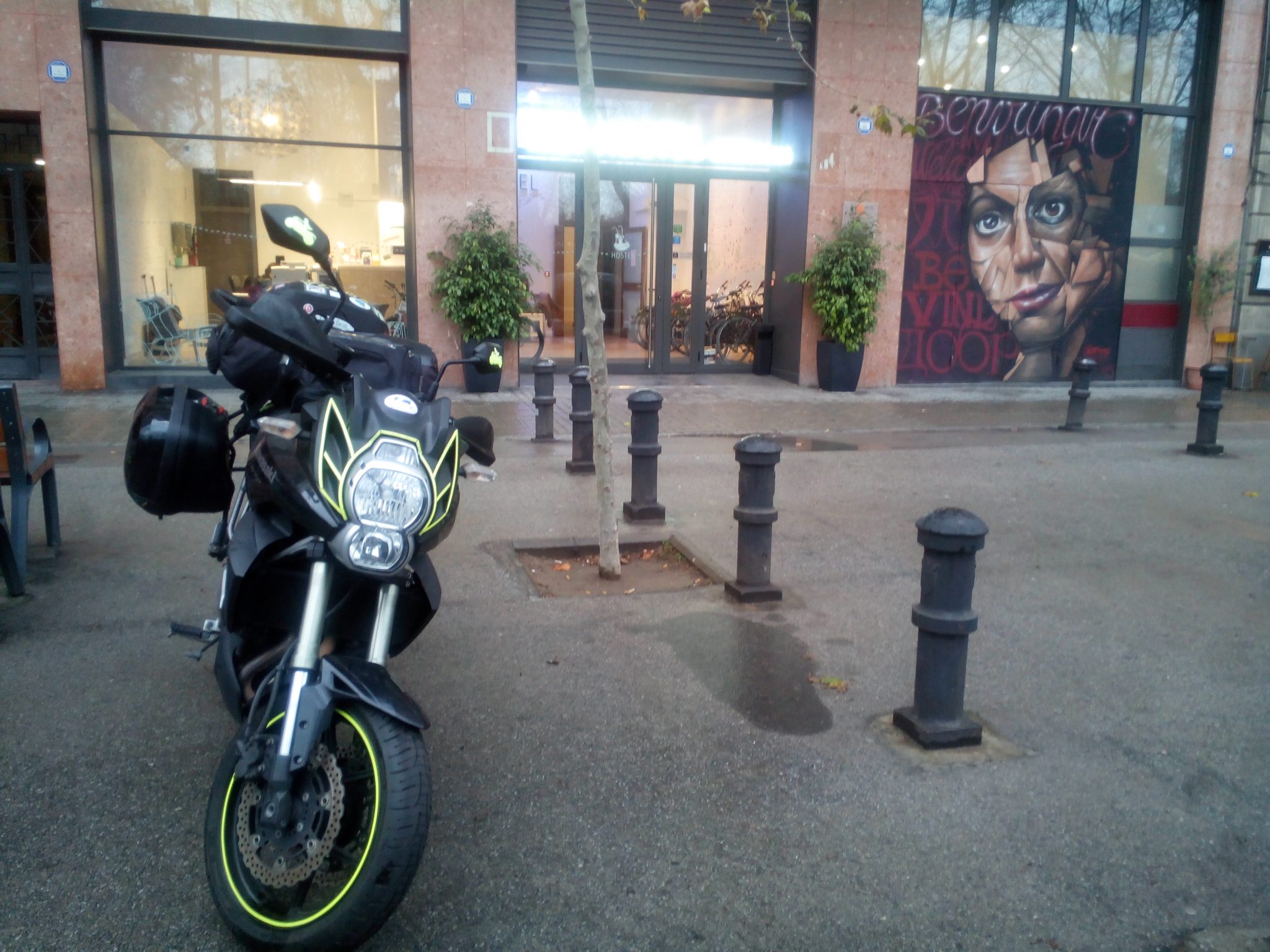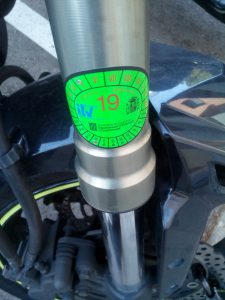Finally, my bike is legal to ride in Spain. It was quite an epic project to get the paperwork done and, although I didn’t intend to keep it here, in the end I’m glad this is how it turned out – we can now continue to explore Spain and Christopher has a seat until we find a bike for him. But let’s start from the beginning. After spending last summer travelling all over Europe, and the autumn house-sitting in the south of England, Christopher and I were ready to return to Spain. I arrived with my bike fully loaded, taking the ferry from Portsmouth to Bilbao, Christopher flew in to Barcelona a few days later. We had decided not to bring his bike, since Koneko is old and therefore probably not worth the hassle and cost in paperwork. Exactly how wise this decision was we realised much later. As for Lazy Cat, my intention was to ride it up to the WIMA rally in Estonia and then keep it in Sweden or even sell it. However, the way it worked out on the job side of life, I could soon see that I wouldn’t be able to afford taking that much time off work before the Spanish holiday period started and that the cost of riding it up and the ferry between Estonia and Sweden was just going to be too costly. Therefore, I booked flights early on and got fairly cheap flights. Since I earn less than 10 euros per teaching-hour, everything must be done on a shoestring and although the fees for paperwork might not seem too bad for people on UK or Swedish salaries, they dig a hole in my budget.
After being slightly misinformed, thinking that I had 3 months not 2 to complete the paperwork for the registration, I started off in a hurry having already wasted the first month. Howver, 8 weeks should still be sufficient – or would it? Yes, so I thought, but there were several things that would go wrong. Firstly, I was told at the ITV (the Spanish for MOT/fordons besiktningen) that I needed a Certificate of Conformity (CoC), and with my Swedish bike papers, passport, NIE certificate and a letter from the town hall stating that I am registered on a local address, they would then start the registration process for the bike. So far so good, I contacted Kawasaki for the CoC, both the Swedish general agent and the Spanish thought that the other should do it – for pretty much the same reasons – but in the end Spanish Kawasaki helped me out, this process took nearly 2 weeks.

The following day, when I happily arrived at the ITV and spread out my papers thinking that maybe they could help me the same day, I met my second obstacle. Indeed, this was not the correct procedure, I had been misinformed – never mind that they were the ones that had misinformed me – I did not need the CoC, I needed to go to the Ministry of Traffic (Jefatura de Trafico) and do a “recuperation” of my old registration number. I should have told them that the bike was registered in Spain originally, never mind that I had told them that I’d bought the bike in Spain 2012 and brought it with me two years later when I moved to Sweden. It was “obviously” my fault. The recuperation was going to cost me 80 euros as well, which made me choke, especially since the inspection itself was 95 euros. Ok, off to the Jefatura de Trafico but nothing could be done there without an appointment so I had to wait another week. This was, of course, very stressful and unlucky because I had been offered 3 days work at an English language camp which I had to turn down in favour of this appointment, the days were ticking and the import tax you’ll have to pay if you fail to complete your paperwork within the time frame is so bloody expensive.
On the day of my appointment, I arrived with my papers and the official put my data into the computer system and told me that I wasn’t recuperating my registration number. He then re-issued my Spanish registration papers, a favour he would “normally only offer Ingemar Stenmark and Pernilla Wiberg”. (I was also advised to exchange my Swedish drivers licence, which is my next challenge after finishing this). So, with my newly printed registration paper (which cost 22 euros) I could buy myself a new registration plate – there was a shop next door to the Jefatura de Trafico that prints them at a cost of 12 euros.
As soon as I got back home I investigated insurance companies and found a suitable offer which could be contracted online – however, contracting online meant being given a phone number to call or they call you. Then the contract details are shared over the phone and the confirmation given (not a small challenge for a foreigner, I must add). This phone confirmed contract was followed up by photos sent in via their special Android app and then an additional electronic signature via e-mail. Here, I felt a great sense of achievement and off I went to the ITV to get a re-issue of the technical inspection card and pass the regular inspection. The one I did last year in Sweden isn’t worth the paper it is printed on here but the bike passed with flying colours last year so, no worries. I was happily thinking that this was the last step and I looked forward to being able to focus on other important matters in my life. But, yet again I was disappointed, and in addition pissed off.

I was unlucky, the small headlight had blown without me noticing, but worse was that I had made “illegal changes” to my bike. Oh yes, it is not permitted to ride without the windscreen, because without it the height of the bike is lower than stated in the papers. Furthermore, the small vibration damper I have which elevates the handlebars by approximately 2 cm is also illegal. And, if this wasn’t silly enough, the hand protectors – which are Kawasaki original and were on the bike when I bought it, were also illegal – they changed the width of the bike by 2 cm in comparison with what is stated in the description. So, either I could seek to legalize these changes or remove them. Could I ride the bike? I asked – well, not at night or on the weekends, only during work hours so it would seem like I was going to a garage or similar was the answer I got. The paper he handed me clearly stated it was illegal to ride the bike if not en route to a garage or ITV. Savouring this information, I decided to not risk it for social rides.
Naturally, I wanted my bike as it is, so I contacted Kawasaki to start the legalization process. Sadly, they could only approve the hand protectors, the windshield had to go back on and the vibration damper be removed. Kawasaki issued a document of conformity allowing for the hand protectors to be installed – please note that after this legalization it will indeed be illegal to remove them. In addition, I had a few other projects: dad had to search and find the windshield, which I luckily had saved in their storage, and it was sent to me for a cost of about 35 euros. I had to pay a garage to remove the vibration damper since the screws were so tight I couldn’t open them myself, this cost 22 euros. I searched the internet to get in contact with Racing House in Seseña, where I bought the bike 5 years ago. I was hoping they could send me a written certificate that the hand protectors were securely installed. Getting hold of Racing House was complicated but I managed in the end, they had moved to Madrid and changed name but were happy to hear from me. However, by the last day of the time window given, I had not yet received any certificate from them so I had to return to the ITV without this last piece of paper.
At the ITV, I handed them all the papers showing the certificate from Kawasaki and pointing out that, look, the hand protectors are Kawasaki originals, and emphasising that the bike was bought like this. All seemed to go well, I was sent back into the office and the official took all my papers and disappeared for a worrying length of time. When he returned, he reminded me that he had indeed told me last time that I needed a certificate from a garage about the installation. When I told him that I’d had trouble finding the firm that sold me the bike since it was 5 years ago but that I was working on it, he answered that I could go to any garage and ask them for the certificate. Enough is enough I thought, and told him that no, I was not going to pay for something that I had already paid for when I bought the bike. He sent me back to the hall with my papers and the inspectors, 3 of them this time, took the bike in again and re-measured it. I almost thought they were going to say it was too long as well, since I have a rack for the top case, but in the end I got the sticker and could ride off. This was such a surprise that I felt a bit shocked.
The re-issue of the technical inspection papers and the cost of the ITV was 41.90 euros and 21 euros respectively. I would have to come back for the papers a few days later but the bike was now legal to ride. I do like stickers, but I’ve never been so happy for a sticker in my whole life.

As a post script – when I did go back for the papers they wouldn’t hand them to me. Not unless I bring the certificate of installation of the hand protectors. In the light of this long and difficult process, we are very pleased that Christopher’s old Honda CG125 remained in England – it would have been too difficult and not to mention expensive to make it road legal here in Spain. Important lesson learned, if, in the future, we buy a new bike, we’ll make sure that all added bits are also legalised in the papers – and that we are given the papers.
Dear Asa, after so much “stress” on legalising your bike. you can look forward to a relaxing WIMA rally in Estland. See you in a week. Rgds. Fokje